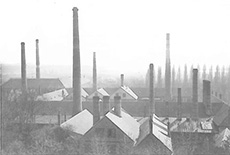The history of the zsolnay factory
Art Nouveau
At the World Exhibition in Antwerp in 1894 and in millennium exhibition in Budapest in 1896, vases with snakes, striated jugs with twisted bodies brought recognition to the factory. A year later, in 1897 in Brussels and in Saint Petersburg the overwhelming Art Nouveau brought great success.

Floral motifs, animal and human shapes, mythological themes appeared on the passionate, romantic, extravagant and sophisticated art pieces. The iridescent eosin technique with its thousand faces enabled a trick of the light on the surface of the ceramics, reminiscent of silk.
In 1900, at the World Exhibition in Paris bringing victory to art nouveau, the Zsolnay factory exhibited a completely new collection. The factory’s Art Nouveau pieces of art were awarded three gold medals. The wide range of products can be illustrated by the fact that there were over one hundred decorative objects with tulip motifs alone.
In 1900 Vilmos Zsolnay died, and the factory was taken over by his son, Miklós, who, continuing his father’s heritage, was committed to the form language of Art Nouveau and kept inventing with new forms, decors and glazes.
Miklós Zsolnay was always open to new ideas; his innovative experimental ideas, technological innovations, created, with the help of his trained workers, a quantity of artwork never seen before.